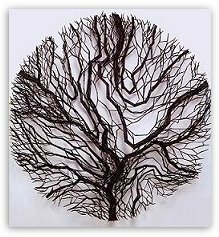|
Integration of Structure, Material, and Process
|
| by Jeffrey Head (12/2002) |
 Harry Bertoia created this sculpture early in his career between 1947 and 1949. It is an exceptional piece, predating his formal career as a sculptor. It is one of the few known examples of his work made from "found materials," in this case, hundreds of steel-cut nails. The piece is also unique since it may be considered his first wall-mounted piece - one of the few he ever created. Ultimately, the most striking quality of this sculpture is Bertoia's source of inspiration: the Torrey Pine, a tree indigenous to La Jolla, California, where he was living at the time. The piece is geographically specific, and is one of Bertoia's more literal representations of nature. Harry Bertoia created this sculpture early in his career between 1947 and 1949. It is an exceptional piece, predating his formal career as a sculptor. It is one of the few known examples of his work made from "found materials," in this case, hundreds of steel-cut nails. The piece is also unique since it may be considered his first wall-mounted piece - one of the few he ever created. Ultimately, the most striking quality of this sculpture is Bertoia's source of inspiration: the Torrey Pine, a tree indigenous to La Jolla, California, where he was living at the time. The piece is geographically specific, and is one of Bertoia's more literal representations of nature.
The composition of the sculpture is technically complex and dynamic. It enables the eye to travel along several paths, or branches, while considering the whole form as it appears, captured for a moment, still growing. Bertoia varied the depth in this piece, in part, to show the geometry he found in nature and to create repetition and rhythm themes that appeared throughout his career. Even with this early sculpture, Bertoia is a master craftsman commanding the "integration of structure, material, and process," which is, to some extent, how he later defined his approach to work.
It was Bertoia's custom not to sign or title his work. He believed the piece itself was a signature, and felt what he created belonged to the universe; and that he did not need to apply his name or a title. A signature..or title would impose personality, meaning, and value, calling attention to the artist rather than the piece itself. He wanted to avoid these limits of classification and categorization. Instead he chose to convey his connection to the universe, and not necessarily remain bound to earthly conventions.
In the late 1940s, Frank and Margaret Shilling acquired this sculpture from Bertoia. The Shillings, acquaintances of Bertoia, were art patrons from Ann Arbor, Michigan, and supporters of the Cranbrook Academy of Art in Bloomfield Hills. They traveled often to San Diego to visit Frank's parents. It is likely during one of these visits they met Bertoia at his home in nearby La Jolla to purchase the piece. The current owner of the sculpture acquired it from Margaret Shilling.
Photo of Harry Bertoia - February 1949
 In 1943, Harry Bertoia left Cranbrook Academy of Art, where he was teaching, to join the war efforts of the Eames Office in Venice, California. That year, while working at the Eames Office, he attended a welding class at Santa Monica City College. A year later he began proto-typing metal frames for the "Eames" chairs. Bertoia worked with Eames until 1946. In 1947, Bertoia moved to La Jolla to work in the Point Loma Navel Electronics Laboratory, where he worked in the publications department producing technical training manuals and reports for equipment operators. During this time he continued to make jewelry and monoprints. He also began his first experiments with metal sculpture. Bertoia stayed in La Jolla until 1949 before moving to Barto, Pennsylvania, at the invitation of Hans Knoll to join Knoll Associates. Bertoia's first exhibition of sculptures was in 1951 at the Knoll Associates Showroom in New York. That exhibition included a standing floor sculpture made with brass-coated nails. In 1943, Harry Bertoia left Cranbrook Academy of Art, where he was teaching, to join the war efforts of the Eames Office in Venice, California. That year, while working at the Eames Office, he attended a welding class at Santa Monica City College. A year later he began proto-typing metal frames for the "Eames" chairs. Bertoia worked with Eames until 1946. In 1947, Bertoia moved to La Jolla to work in the Point Loma Navel Electronics Laboratory, where he worked in the publications department producing technical training manuals and reports for equipment operators. During this time he continued to make jewelry and monoprints. He also began his first experiments with metal sculpture. Bertoia stayed in La Jolla until 1949 before moving to Barto, Pennsylvania, at the invitation of Hans Knoll to join Knoll Associates. Bertoia's first exhibition of sculptures was in 1951 at the Knoll Associates Showroom in New York. That exhibition included a standing floor sculpture made with brass-coated nails.
|